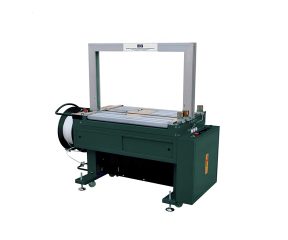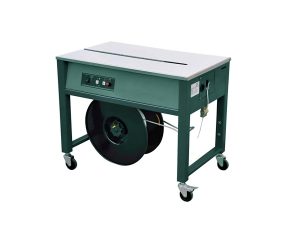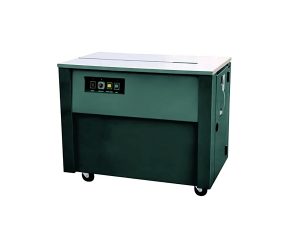
Types of Strapping Machines
There are different types of strapping machines available on the market, including semi-automatic, automatic, handheld, and pallet strapping machines.
- Semi-Automatic Strapping Machines:
- Automatic Strapping Machines:
- Handheld Strapping Machines:
- Pallet Strapping Machines:
These machines require an operator to manually feed the strap around the package and then activate the machine to tension and seal the strap.
These machines are fully automated and require minimal operator intervention. They can automatically feed, tension, and seal the strap around the package.
These machines are operated manually and are designed for smaller packages. The operator manually tensions and seals the strap using a handheld tool.
These machines are fully automated and are designed for strapping large packages or pallets. They automatically feed, tension, and seal the strap around the package.
Factors to consider when choosing a strapping material
There are various strapping materials available on the market, including steel, polyethylene terephthalate, and polypropylene. Each material has its own strengths and weaknesses, and it is important to consider these factors when choosing a strapping material.
- Steel:
- Polyethylene terephthalate:
- Polypropylene:
Steel straps are the strongest and most durable strapping material available. They are ideal for heavy-duty applications that require maximum strength and security. However, steel straps are also the most expensive and are not suitable for all applications.
Polyethylene terephthalate straps are strong, flexible, and have a high elongation rate, which makes them ideal for securing irregularly shaped or fragile items. They are also resistant to corrosion and can be used in outdoor applications. However, polyethylene terephthalate straps are not as strong as steel straps and are more expensive than polypropylene straps.
Polypropylene straps are the most commonly used strapping material. They are lightweight, inexpensive, and can be used for a wide range of applications. However, they are not as strong as steel or polyethylene terephthalate straps and are not recommended for heavy-duty applications.
How Strapping Machines Work
Strapping machines work by feeding a strap around a package, applying tension to the strap, and sealing it to secure the package. The machine uses a variety of mechanisms, including feed wheels, grippers, and sealing bars, to perform these tasks. The operator can adjust the tension and strap width according to the specific requirements of the package.
There are several advantages of using strapping machines, including:
- Increased Efficiency:
- Improved Safety:
- Consistent Quality:
- Cost-Effective:
Strapping machines can significantly increase packaging efficiency by reducing the time and labor required to secure packages.
Strapping machines can improve workplace safety by reducing the risk of injuries associated with manual strapping.
Strapping machines ensure consistent quality of packaging, which can enhance the reputation of your brand.
Strapping machines can help reduce packaging costs by minimizing material waste and reducing labor costs.
Factors to Consider When Choosing a Strapping Machine
When choosing a strapping machine, there are several factors that must be considered to ensure the machine meets your specific needs. Here are some of the main factors to consider:
- Production rate requirements:
- Type of goods to be strapped:
- Strapping material compatibility:
- Cost of the machine:
- Maintenance and repair requirements:
The production rate of your facility will determine the type of strapping machine you need. A high-speed strapping machine will be required for facilities with high production rates, while a lower speed machine may be sufficient for those with lower production rates.
The type of goods being strapped will determine the type of strapping material and machine that is required. For example, fragile items may require a gentler touch, while heavy items will require stronger strapping material and a machine with higher tension capabilities.
Different strapping materials have different compatibility requirements with machines. It is important to ensure that the machine is compatible with the strapping material you plan to use.
The cost of the machine will vary depending on the features and capabilities required. It is important to find a machine that meets your needs at a reasonable price.
Consider the maintenance and repair requirements of the machine to ensure it is practical and cost-effective for your business.
Technical Specifications
When choosing a strapping machine, it is important to consider its technical specifications. Here are some of the main technical specifications to consider:
- Maximum and minimum strapping tension:
- Strapping speed:
- Strap width and thickness:
- Machine dimensions and weight:
- Power requirements:
The maximum and minimum strapping tension of the machine will determine the strength of the strap and the type of goods that can be strapped.
The speed of the machine will determine how quickly goods can be strapped. A high-speed machine may be necessary for facilities with high production rates.
The width and thickness of the strapping material will determine the strength of the strap and the type of goods that can be strapped.
The dimensions and weight of the machine will determine where it can be located and how easily it can be moved.
The power requirements of the machine will determine the electrical needs of your facility and the cost of operation.
Common Applications of Strapping Machines
Strapping machines are used in a wide range of industries and applications, including:
- Packaging of goods:
- Shipping and logistics industries:
- Warehouse and storage facilities:
- Construction and manufacturing industries:
Strapping machines are used to securely package goods, preventing damage during transit.
Strapping machines are used to secure packages and pallets for transport.
Strapping machines are used to secure goods for storage and inventory management.
Strapping machines are used to secure building materials and equipment during transport.
Maintenance and Repair of Strapping Machines
Proper maintenance and repair of strapping machines is critical for their longevity and optimal performance. Here are some important considerations for maintaining and repairing your strapping machine:
- Daily, weekly, and monthly maintenance requirements:
- Common issues and troubleshooting tips:
- Importance of regular maintenance:
Strapping machines require regular maintenance to ensure they operate effectively. Check the machine’s manual for recommended maintenance schedules.
Be aware of common issues that can arise with strapping machines and know how to troubleshoot them.
Regular maintenance can prevent breakdowns and extend the life of your machine, ultimately saving you money in the long run.
Environmental Considerations
Strapping machines have a significant impact on the environment, particularly in terms of the materials used for strapping. The most common strapping materials are plastic, which can take hundreds of years to decompose. Therefore, sustainability considerations must be taken into account when selecting strapping materials. Green alternatives for strapping materials include biodegradable and compostable materials made from plant-based sources. Additionally, there are now strapping machines available that operate on renewable energy sources, such as solar power.
Safety Precautions and Regulations
Safety is of utmost importance when operating strapping machines. The Occupational Safety and Health Administration (OSHA) has regulations in place for the safe use of strapping machines. Operators must be trained to identify and avoid potential hazards associated with strapping machines, such as pinch points, cutting hazards, and electrical hazards. Additionally, training requirements for strapping machine operators must be met, including instruction on the proper use, maintenance, and adjustment of the machines.
Comparison with Other Packaging Methods
Strapping machines offer several advantages over other packaging methods, such as shrink wrapping and tape sealing. Strapping machines provide a secure and tight seal, making them ideal for heavy-duty packaging needs. Additionally, strapping machines are more cost-effective than other methods, reducing material waste and increasing productivity.
Integration with Automation and Industry 4.0
Strapping machines can be integrated with other automated systems, such as warehouse management systems, to improve productivity and accuracy in inventory management and shipping operations. Industry 4.0 applications can also be utilized to monitor and optimize the performance of strapping machines, improving efficiency and reducing downtime.
Choosing a Strapping Material Supplier
Choosing a reliable and quality strapping material supplier is essential for ensuring consistent and reliable performance of strapping machines. The relationship between the supplier and strapping machine manufacturer is critical, as compatibility between materials and machines must be considered. Availability and lead times of strapping materials should also be considered when selecting a supplier.
Cost Analysis and ROI
Calculating the return on investment (ROI) of purchasing and operating a strapping machine requires considering several factors, including the cost of the machine, maintenance costs, and the cost of strapping materials. The ROI of a strapping machine can be significant, resulting in increased productivity and reduced material waste.
Customization and Flexibility
Strapping machines offer several options for customization to meet specific packaging needs. Flexibility in adjusting strapping parameters allows for the use of different types of products and materials, making strapping machines ideal for various applications.
International Standards and Certifications
Complying with international standards and certifications related to strapping machines and materials is critical for ensuring safety and quality assurance. Overview of international standards and certifications related to strapping machines and materials are available to manufacturers and suppliers, and it is essential to adhere to these standards to prevent injuries and ensure quality performance.
Maintenance and Repair Service Providers
Choosing a qualified and reliable maintenance and repair service provider for strapping machines is essential to maintain the efficient operation of the machines. Qualifications and expertise of the service provider, along with the service contracts and response times for emergency repairs, should be considered when selecting a provider.
Ergonomics and Worker Safety
Design features of strapping machines should prioritize improved ergonomics and worker safety to minimize injuries and accidents in the workplace. The importance of reducing repetitive motion injuries and accidents in the workplace should be considered when designing strapping machines.
Industry Trends and Innovations
Current and emerging trends in the strapping machine industry include innovations in strapping machine technology, materials, and applications. Increased automation and digitalization of strapping machines are expected to improve efficiency and productivity in the packaging industry.
Training and Education
Training and education are critical for safe and efficient use of strapping machines. Companies should ensure that operators receive appropriate training before using the machines. Training requirements may vary depending on the complexity of the machine, the type of material being strapped, and the application. Training should cover topics such as machine operation, safety procedures, troubleshooting, and maintenance. Companies should also provide ongoing education and training opportunities for maintenance and repair technicians to keep their skills and knowledge up-to-date.
Choosing a Strapping Machine Manufacturer
Selecting a reliable and reputable strapping machine manufacturer is crucial to ensure that companies receive high-quality products and services. Companies should consider factors such as the manufacturer’s experience and reputation, the range of products and services offered, the level of customer support, and the quality of after-sales service. Companies should also look for manufacturers that offer customization options to meet their specific needs and requirements.
Integration with Warehouse Management Systems
Integrating strapping machines with warehouse management systems can help improve productivity and accuracy in inventory management and shipping operations. Companies should look for machines that can be easily integrated with existing software systems, such as barcoding or RFID, to streamline operations and reduce errors. Integration can also enable real-time monitoring of machine performance and provide valuable data for continuous improvement.
Industry-Specific Applications
Strapping machines are used in a variety of industries, each with its unique needs and requirements. For example, food and beverage companies may require machines that can handle wet or sticky products, while pharmaceutical companies may require machines that meet strict sanitation standards. Companies should consider their specific industry requirements when choosing a strapping machine and look for manufacturers that specialize in their industry.
Data Analytics and Performance Monitoring
Using data analytics and performance monitoring tools can help optimize strapping machine performance and reduce downtime. Companies should look for machines that can be connected to IoT or other digital technologies to collect and analyze data on machine performance, maintenance needs, and other key metrics. This data can be used to identify trends and patterns, optimize machine settings, and predict maintenance needs to reduce downtime and maintenance costs.
Maintenance and Repair Training for Operators
Providing training and resources for operators to perform routine maintenance and minor repairs on strapping machines can help reduce downtime and maintenance costs. Companies should ensure that operators have access to manuals, troubleshooting guides, and other resources to help them address common issues. Companies may also consider offering training programs to teach operators how to perform routine maintenance tasks, such as changing the strapping material or adjusting the tension.
Regulatory Compliance
Companies must ensure that their strapping machines comply with all applicable regulations and standards related to safety, materials, and other factors. Companies should stay up-to-date with relevant regulations and certifications, particularly for international operations. Manufacturers may provide guidance and support in meeting regulatory requirements.
Strapping Machine Leasing and Rental
Leasing or renting strapping machines can be a cost-effective alternative to purchasing outright, particularly for short-term or temporary needs. Companies should consider factors such as the length of the lease, the cost of maintenance and repair, and the availability of spare parts when choosing a leasing or rental agreement.
Conclusion
In conclusion, strapping machines are a versatile and essential tool for many businesses, offering increased efficiency, safety, and cost savings. Companies should carefully evaluate their needs and requirements when choosing a machine, selecting a reliable manufacturer, and integrating with warehouse management systems. Ongoing training and maintenance are critical for safe and efficient operation, and companies should stay up-to-date with regulatory requirements and explore leasing or rental options as needed.




